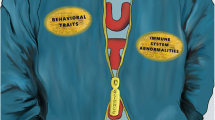Abstract
Several investigators, including ourselves, have reported significant changes in various immune responses in children with autism. These changes demonstrate dysregulation of the immune system (deficiency in some components of the immune system and excesses in others). In addition, certain genes in the major histocompatibility complex (that regulates immune responses) appear to be involved in autism. Based upon immunological abnormalities, various treatment modalities have been applied to children with autism. In this brief review, these immunological changes and various biological therapies are analyzed and summarized.
Similar content being viewed by others
REFERENCES
Cardinali, D. P. (1977). Effect of pentoxifylline and theophylline on neurotransmitter uptake and release by synaptosome-rich homogenates of the rat hypothalamus. Neuropharmacology, 16, 785–790.
Fiers, W., & Buurman, W. A. (Eds). (1993). Tumor necrosis factor: Molecular and Cellular Biology and Clinical Relevance. Basel, Switzerland: Karger.
Fudenberg, H. H. (1996). Dialyzable lymphocyte extract (DlyE) in infantile onset autism: A pilot study. Biotherapy, 9, 143–147.
Gupta, S. (1998). Intravenous immunoglobulin therapy in neurological disorders. Western Journal of Medicine, 167, 349–350.
Gupta, S. (1999). Treatment of children with autism with intravenous immunoglobulin. Journal of Child Neurology, 14, 203.
Gupta, S., Aggarwal S., & Heads, C. (1996). Dysregulated immune system in children with autism: Beneficial effects of intravenous immune globulin on autistic characteristics. Journal of Autism and Developmental Disorders, 26, 439–452.
Gupta, S., Lee, T., & Aggarwal, S. (1998). Alterations in Th1 and Th2 subsets of CD4??and CD8??T cells in autism. Journal of Neuroimmunology, 14, 499–504.
Gupta, S., Rimland, B., & Shilling, P. D. (1996) Pentoxyfylline: A brief review and rationale for its possible use in the treatment of autism. Journal of Child Neurology, 11, 501–504.
Hawkins, E. S., & Ribeiro, H. A. (1987). Pentoxifylline review. Journal of American Podiatric Medical Association, 77, 645–647.
Kitatani, T., Watanabe, T., & Shibuya, T. (1993). Different effects of methyxanthines on central serotonergic postsynaptic neurons in a mouse behavioral model. Pharmacology Biochemical Behavior, 44, 457–461.
Menage, P., Thibault, G., Barthelemy, C., Lelford, G., & Bardos, P. (1992). CD4??CD45RA??T lymphocyte deficiency in autistic children: Effect of a pyridoxin-magnesium treatment. Brain Dysfunction, 5, 326–333.
Mintz, M., Rapaport, R., Oleske, J. M., Connor, E. A., Koenigsberger, M. R., & Denny, T. (1989). Elevated serum levels of tumor necrosis factor are associated with progressive encephalopathy in children with acquired immunodeficiency syndrome. American Journal of Diseases of Children, 143, 771–774.
Mountz, J. M., Tolbert, L. C., Lill, D. W., Katholic, C. R., & Liu, H. G. (1995). Functional deficits in autistic disorder: Characterization by technetium-99m-HMPAO and SPECT. Journal of Nuclear Medicine, 38, 1156–1162.
Plioplys, A. V. (1998). Intravenous immunoglobulin treatment of children with autism. Journal of Child Neurology, 13, 79–82.
Romagnani, S. (1995). Biology of Th1 and Th2 cells. Journal of Clinical Immunology, 15, 121–129.
Rumsey, J. M., & Ernst, M. (in press). Functional neuroimaging of autistic disorders. Invited review. Mental Retardation and Developmental Disabilities Research Reviews.
Schandene, L., Vandenbussche, P., Crusiaux, A., Alegre, M. L., Abramowicz, D., DuPont, E., Content, J., & Goldman, M. (1992). Differential effects of pentoxifylline on the production of tumor necrosis factor-alpha (TNF-?) and interleukin-6 (IL-6) by monocytes and T cells. Immunology, 76, 30–34.
Schwartz, S. A. (1990). Intravenous Immunoglobulin (IVIG) for the therapy of autoimmune disorders. Journal of Clinical Immunology, 10, 81–89.
Singh, V. K., Warren, R. P., Odell, J. D., Cole, P., & Warren, L. (1993). Antibodies to myelin basic protein in children with autistic behavior. Brain, Behavior and Immnity, 7, 97–103.
Singh, V. K., Warren, R. P., Averett, R., & Ghaziuddin M. (1997). Circulating autoantibodies to neuronal and glial filament protein in autism. Pediatric Neurology, 17, 88–90.
Wakefield, A. J., Murch, S. H., Anthony, A., Linnell, J., Casson, D. M., Malik, M., Berelowitz, M., Dhillon, A. P., Thomson, M. A., Harvey, P., Valentine, A., Davies, S. E., & Walker-Smith, J. A. (1998). Ileal-lymphoid-nodular hyperplasia, non-specific colitis, and pervasive developmental disorder in children. Lancet, 351, 637–641.
Warren, R. P, Foster, A., & Margaretten, N. C. (1987). Reduced natural killer cell activity in autism. Journal of the American Academy of Child and Adolescent Psychiatry, 26, 333–335.
Warren, R. P., Foster, A., Margaretten, N. C., Pace, N. C., & Foster, A. (1986). Immune abnormalities in patients with autism. Journal of Autism and Developmental Disorders, 16, 189–197.
Warren, R. P., Odell, J. D., Warren, W. L., Burger, R. A., Maciulis, A., Daniles, W. W., & Torres, A. R. (1996). Strong association of the third hypervariable region of HLA-DR??with autism. Journal of Neuroimmunology, 67, 97–102.
Warren, R. P., Singh, V. K., Cole, P., Odell, J. D., Pingree, C. B., Warren, W. L., & White, E. (1991). Increased frequency of the null allele at the complement C4b locus in autism. Clinical and Experimental Immunology, 83, 438–440.
Warren, R. P., Singh, V. K., Cole, P., Odell, J. D., Pingree, C. B., Warren, W. L., DeWitt, C. W., & McCullough, M. (1992). Possible association of the extended MHC haplotype B44-SC30-DR4 with autism. Immunogenetics, 36, 203–207.
Warren, R. P., Yonk, J., Burger, R. W., Odell, D., & Warren, W. L. (1995). DR-positive T cells in autism: Association with decreased plasma levels of the complement C4b protein. Neuropsychobiology, 31, 53–57.
Yonk, L. J., Warren, R. P., Burger, R. A., Cole, P., Odell, J. D., Warren, W. L., White, E., & Singh, V. K. (1990). CD4??helper T cell depletion in autism. Immunology Letters, 25, 344–346.
Author information
Authors and Affiliations
Rights and permissions
About this article
Cite this article
Gupta, S. Immunological Treatments for Autism. J Autism Dev Disord 30, 475–479 (2000). https://doi.org/10.1023/A:1005568027292
Issue Date:
DOI: https://doi.org/10.1023/A:1005568027292




